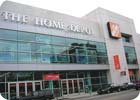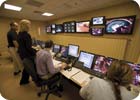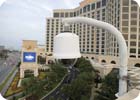
It’s
customer service – Safeguarding patients, visitors, staff and hospital
equipment is the mission. With more access controls than some others, John
Blasko stresses customer service from a public safety perceptive.

On the surface, their security needs and solutions should not have much in common: A community hospital, a large school district, a global financial company, a fast-food chain and a local branch of a national hardware chain. But when it comes right to it, large or small, global or local, there is a common thread to their security needs.
Technology is used by all. It is very important, and many are foraying into cutting edge. But they all agree that people and communications form the backbone of their most important security solutions.

It’s
tying security into the business – There are unique risks with a restaurant
open late at night, with cash on hand and few people on duty. So Gerry Brandt
concentrates on honest assessments, training, workable policies and procedures.
PEOPLE ARE PARAMOUNT
“The most critical security element is the people you hire,” Damstrom says. “That’s true in the whole financial service sector and in any industry. It’s critical how your people think about security. Either you have evolutionary or revolutionary change in terms of the use of technology.”Damstrom says he tries to hire people with diverse backgrounds. “The security element that works the best for me is hiring a diverse employee population so we can have a different kind of critical thinking. A lot of folks who run global security programs come out of law enforcement, military, etc. But if you can have a mix of professionals that haven’t been ‘institutionalized’ by some government agency, they can bring a different viewpoint to the debate.”
For Subway, employees and franchise owners are keys to the security program, Brandt says. “You can have the best security video system in the world, but if you turn it off, you are not doing any good.
“The people have to participate. They are in the business of selling sandwiches. That is primarily their mission, to move product. As a security expert, we also have to get them to understand that to be successful they have to have a good security program. If they don’t make a sandwich well, they may lose a customer. If they don’t do security well, they may lose everything, including their store, their college fund for their kids, etc. It’s huge.”
The school district relies on people in a slightly different way. “What we try to do is start off by making sure every school in the district has a trained safety team,” Melita says. “Every school has a safety plan done in conjunction with police and fire. We have complete collaboration with them. That makes us unique. We also have a safety and security committee, one representative from each department in the district, including the PTA. Everyone works together.”
Melita also points to the need to train and communicate how the security system works. “You can have all the technology in the world, but if people don’t know how to use it, it won’t do any good. A lot of times schools are handed equipment but they don’t know what it is about or how to use it.”
The people element extends not just to employees, but also to customers, in some cases.
“I always preach to employees that customer service is the most important thing,” Home Depot’s Alfaro says. “The customer will appreciate it, but the guys that come to deprive us of merchandise like to come into a store and not be greeted or noticed. We can invest in cameras or alarm systems, but if we don’t have people on the sales floor talking to customers, things are going to happen.”
At the hospital, customer service is the key to making a strict security system “friendly” to visitors, Blasko says. “Our access control is more restrictive than most in the area. You can’t get anywhere but the first floor without a badge.
“The front desk is where we hand out badges. Because there are more restrictions on access, customer service is at the forefront to make it as friendly as possible and not make people feel like they are walking into a prison.”
Cooperation of visitors and employees in any of these sectors is vital to the safety and security of all.
“One of the most important elements in our communication processes is being able to let individuals know whether or not they are in harm’s way,” Damstrom says. “I would expect horizontally and vertically across all industries, we in this business are about influencing human behavior at a certain point in time. When bad things are happening, corporate security facilities are in the crisis prevention business.
“What we have learned is that people will do what you ask them to in times of crisis if you have built credibility with them. The only way to do that is to communicate with them beforehand. If the first time they are hearing from corporate security is at a time of crisis, they won’t listen. You haven’t built credibility.”

It’s
a community effort – Awareness of who is on campus is an essential need for Dr.
Joe Melita. Education cannot succeed if a facility is not safe and secure;
there needs to be confidence from the children, parents, teachers and
administrators.
TECHNOLOGY THOUGHTS
Security technology is obviously the focal point of almost any security plan these days. While security needs vary in these diverse situations, almost all of them have access control or security video, or both. And they are always thinking ahead to the next level.“Our access control system is what makes us unique,” Blasko says. “No one else in this area has the level of control we have. Originally it was just for our employees, but then we expanded it to visitors. A lot of people comment on how secure our hospital is.”
The hospital also uses cameras with DVRs. “I’ve learned to love the DVR as opposed to video tape. It makes it really easy to find what you are looking for,” he says.
Subway recommends security video systems tied in with cash registers to their store owners. “From a technology standpoint, a digital video system with a cash register interface works very well for us,” Brandt says. “If a system is properly installed and maintained it can act as a deterrent and becomes a management tool.”
Broward County schools are in the process of moving from digital cameras to IP cameras, Melita says. They have also just installed a brand new visitor management system that automatically scans people against the national sexual predator database.
With such a huge base, Lehman Brothers doesn’t rely on any one formula for security, but instead has a security technology “platform” that breaks down into several disciplines.
“On our baseline we are looking for execution and implementation across the platform of our access control and video systems,” Damstrom says. “Then we use biometrics in our high security areas. It is a varied platform, but the ultimate goal is to use these technologies where they add value to the firm, to help the firm be successful.”
Damstrom is always looking at the future of technologies. For example, they are building RFID into their access control system to better track employees at the time of critical incidents. He also would eventually like to move more into biometrics.
On the security video side, Lehman is also moving to IP cameras. “The infrastructure, the stuff people don’t usually see, has become much more efficient in terms of moving data,” he says. “The other side to that is the capability to retrieve data, because it is on a hard drive, has become really efficient.”
Finally, he stresses the importance of open systems connected by IT. “Everything we do today is going to intersect with our information technology group. These systems are no longer ‘closed’ systems.”

It’s
greeting and noticing – Loss prevention is always upfront for Oscar Alfara.
With the type of merchandise in these retail facilities, safety of customers
and sales associates is also a major concern.
LESSONS LEARNED
In the course of their experiences, all five have learned valuable lessons about security and how best to approach it.“I think basically you have to try new things,” Blasko says. “Sometimes the only way to know you found a better way is to try it and see what happens. Failure is part of success.” He recommends that facilities – particularly hospitals and others on restrictive budgets – start slow and choose wisely when it comes to technology. “Be selective and get the most bang for your buck, especially when you are talking about technology, because it’s not cheap. Sometimes you can’t keep up with the Joneses because that will destroy what you are trying to do.”
Damstrom agrees. “You need to benchmark against what you are trying to protect. Once you have identified what you are protecting and what the threats are against it, develop a strategy before you start reaching for solutions. Our goal is to be as self-resilient as we possibly can within finite resources.”
Brandt stresses keeping this in mind: “The goal is to minimize opportunity for security-related incidents. It’s a case of understanding what your goal should be, then meeting or exceeding it. Then if something does happen, you feel you have done your very best.”
Melita feels the best way to establish a good security program is to listen. “We all have our specialties. We have to listen to what the needs are and make an assessment. Sometimes you are ready to hear one thing and you have to slow down and really assess what your needs are. Listen very carefully to the needs of your stakeholders.”
Alfaro adds: “It’s always important to have a good business partnership because people will be more receptive. At the end of the year, we are looking to have a good shrink percentage. But it’s also about understanding that there are other needs in the store. It is not just loss prevention. We need to be willing to help them, be a resource for them and come up with a solution to the problem.”
In the end, Damstrom concludes, all you can do is your best. “One of the key elements of the businesses we are in is that there is no perfect defensive system. It doesn’t exist. What we try to do is identify risks and continue to mitigate them by hiring diverse individuals or layering technologies.”

SIDEBAR 1: Meet The Companies
Security Magazine interviewed security executives at five different facilities in five separate markets. Their top security concerns are specific to their individual circumstances.Riverside Community Hospital, Riverside, Calif. – with 364 beds, 1,400 employees and four professional buildings, Riverside is a medium-sized hospital. “I think our biggest need for security is safeguarding our patients,” says John Blasko, operations manager for public safety at the hospital. “We have had troubles with transients going up to floors and sleeping in beds.”
Lehman Brothers – A global investment bank with 24,000 employees and sites in 24 countries, Lehman has a variety of security needs. “Our needs for security run through a spectrum of solutions,” says Ken Damstrom, managing director, global corporate security for Lehman Brothers. “Ultimately we are trying to protect our people. Our primary assets go up and down the elevator each night. We are also concerned about data, brand and reputation.”
Subway Restaurants – There are 26,000 Subway stores worldwide. The number changes every week, but each store is an independently-owned franchise. “Decisions for security at a location are up to the owner. We work with the franchisor to recommend procedures and policies,” says Gerry Brandt, national security consultant with Subway, Lake Villa, Ill. “Staffing is relatively small. There may be only two or three people on duty. Facilities that are open late at night, handle cash and deal with the public are frequent targets for robbery. We spend a lot of time making training available for stores and advising them of the risk of being in the business.”
Broward County Schools – Broward is the sixth largest school district in the nation, with 270,000 kids, 40,000 employees and 260 sites. “Basically the awareness of who is on our campus is our priority,” says Dr. Joe Melita, executive director, professional standards/special investigative unit, Broward County Schools. “We are dealing with kids. We are responsible to the parents that when they send their kids to school, they are safe and secure.”
Home Depot, West Stockton, Calif. – The West Stockton Home Depot is one building with 180 employees. “In retail, the main thing we need is loss prevention,” says Oscar Alfara, loss prevention manager. “Safety at a place like this is also very important with the type of merchandise that we are selling.”

SIDEBAR 2: ‘Sticky’ Ideas Stick
Successful security executives such as the five featured in this cover story know how to sell their programs, budgets and new ideas to their CEO.But not everything may stick.
Stanford University Professors Chip Heath and Dan Heath, in their Random House book, Made to Stick: Why Some Ideas Survive and Others Die, have some strategies that are as good as glue.
Credibility – Think of it as a bank account. Over the years, chief security officers build up their account and use it constantly to sell their budgets and new ideas.
Simplicity – There are Ten Commandments, not 50. Concrete ideas simply expressed are easier to understand for busy top executives often focused on multiple concerns, departments and directions. Since the Reagan White House days, U.S. Presidents get one page issues briefings that boil down complexities to essential that can be expanded after decision-making.
Tell the story – In explaining a new threat or need for more funding or technology, make your case in a real-life way. Mention specific people situations and don’t forget the emotional side of the equation, too. While assets, brand and reputation are to be protected, the bottom line is the people, who will be harmed by any type of attack or incident. – Reported by Bill Zalud, Editor

Casinos
are like cities except there is more security technology and often more security
officers on patrol. At Beau Rivage, staff training and high tech security video
comes together in an effective control room.
SIDEBAR 3: BONUS FACILITY: Relationships Make the Difference at Casinos
Of course, it is important to have the correct people on staff, but correct relations with law enforcement also is important for Eric Newton, director of security Beau Rivage, subsidiary of MGM Mirage in Biloxi, Miss. “We try to maintain a good relationship with FBI and U.S. Air Force base authorities. As far as people go, it does boil down to staff. We totally depend on staff to be there and be alert, and have buy-in on entire program,” says Newton, who agrees with our five security executives elsewhere in this cover story.Beau Rivage is a 29 story hotel/resort facility. There are approximately 1,750 rooms with 10,000-15,000 visitors and employees per day.
“When people ask me about the security in a large resort like this, I tell them this is really like a small city. We have everything a small city has from residences, to spas, salons, swimming pools, parking structures. One advantage we have is an elaborate video system (Rapid Eye from Honeywell in conjunction with North American Video) where a city wouldn't. We have the ability to go back and review video to see what really happened. I also have more intense coverage from a personnel aspect – more officers per square foot than a typical city.”
Proper officer training is crucial, according to Newton.
From the time a security officer comes on board, each goes through a 40 hour academy from CPR and AED to basic firefighting. “This department is really a paramedic, fire and police department. We’re all three.” Also having an effective security video system with personnel who know how to use it is crucial, too.

Images
inside and outside go to DVRs. In addition, Beau Rivage’s security operation
has license plate and facial recognition systems.
There are key control systems including newer tech based on hand scanners. An employee has to place his or her hand in it to release keys. “We must tightly control keys because of the nature of our business.”
Newton now has license plate recognition systems. “We maintain a database of cars coming and going on property and off. It’s also effective from a homeland security standpoint.” There are also facial recognition systems. “Those are good to compare a person’s face to FBI databases and even our own database of people who have been banned,” he adds.
On the video side, what’s new are digital video recorders replacing VHS tapes. The advance “makes our job about 1,000 times easier. When going back to review, it’s so much easier to transmit that information to people in the company that need it. Quality is just outstanding.”
Newton’s advice to others outside of the gaming industry: “The training. A lot of places will do some initial training when they first get employees in the door. Then they just kind of place them on post. Security folks love training. They love to get certificates saying they’ve been trained. Not only original but recurring training is among key factors.”
